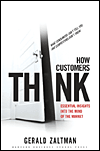|
How Customers Think: Essential Insights into the Mind of the Market / Gerald
Zaltman / Harvard Business School Press
Published in The Marker
Magazine, September 2007, in "
The
Management Bookworm
" column written by Ari Manor, CEO of ZOOZ.
Gerald Zaltman is a Harvard Business School professor and a partner in OZA, a marketing research institute. He served as President of the American Consumer Research Association, is considered one of the most sought after marketing lecturers, and has written 14 professional books to date. His book
“How Customers Think” focuses on how to conduct in-depth studies to better understand what customers want. This is a unique and important book that describes an assortment of tools to conduct advanced market researches, and particularly to expose the unconscious thoughts of customers. Unfortunately, the book is very difficult to digest, which occasionally happens when the author is an academic and the field is scientific and complex (market researches, and at length – brain science and cognition). In addition, many parts of the book deal with theory and methods in status nascendi that have not yet been properly formed and matured. However, two main topics in the book are critical for all Marketing professionals, and have been written in a fairly clear and comprehensible fashion. This bookworm, which tends to recommend only practical and readable management books, has decided to deviate from its habit this time, and will recommend these two topics to you.
The first topic is entitled “The Foolishness Called Focus Groups”. These pages should be photocopied and distributed to every Marketing Manager, Brand Manager, Market Researcher and Advertising Manager.
Focus Groups are apparently the most common marketing research method in Israel, which focus on questioning approx. 10 customers, with the help of a professional facilitator, about their opinions and feelings toward brands and innovations in a specific product category. The book emphatically stresses that focus groups should not be used as a basis for decision making, for a number of reasons: it is
not a scientific or proven method; it does not foster a relationship of trust between the facilitator and the participants (even though trust is essential to obtaining open and honest answers); the effectiveness of the questioning decreases tremendously in groups with more than 4 participants; attempts participants in the focus groups make to get attention or appease the group hide their true thoughts; and worse of all – focus groups do not succeed in getting to the bottom of the consumers’ thoughts and feelings (even when a participant manages to present an opinion or feeling, the context and reasons are not explained).
Studies show that 95% of our thoughts (even those that affect our purchasing decisions) are completely subconscious. And since the focus groups are not capable of exposing what happens in the consumers’ subconscious, other tools are necessary. The book describes a wide variety of these tools. One of them,
Metaphor Study (using in-depth interviews), is the second part of the book that shouldn’t be missed. Metaphors are apparently the language from which the subconscious and memory are comprised, and therefore also constitute the best way to reveal subconscious thoughts.
When a consumer is asked about his feelings and beliefs in a one-on-one interview (for example regarding a known brand or any sort of innovative idea), some metaphors are always intertwined in his answers. For example, the first paragraph in this section describes a consumer’s opinion (the writer of this section) about a product (the book that is recommended here). Among other things, the following metaphors appear in this paragraph: “in-depth studies”, “assortment of tools”, “expose thoughts”, “a
very difficult book to digest”, “methods that have not yet matured”.
It turns out that it is possible to analyze the common denominator of metaphors that consumers raise (by ignoring their other answers) and thus to describe central beliefs and feelings that are in consumers’
subconscious. For example, the metaphors “in-depth studies” and “expose thoughts” allude to “digging, revealing internal layers”, and this new metaphor, which is not explicitly mentioned, can be used to market the book for example (“Diamonds in the customer’s mind” or “digging for thoughts” will be more successful titles for the book than “How Customers Think”.
Likewise, the metaphors “a difficult book to digest” and “methods that … have
not yet matured” allude to a negative opinion about the book connected to “inedible food”. Such an expose of negative opinions can lead to an improvement of the product, and in our example to increased book sales. For example, the author can be instructed on how to rewrite the book and turn it into a “tastier snack” in any way possible (changing the order of the chapters, adding clarifying examples, organizing the text into shorter and more comprehensible sentences, summarizing the main points at the end of each chapter, etc.).
A metaphor study, the second topic that is important to read in this book, changes the ways the customers’ needs are revealed. This is where its importance lies. For the first time it is possible to reveal subconscious attitudes in a systematic, efficient, and inexpensive manner. This is a true revolution in subconscious research, which may change the foundations of psychology, sociology, and behavioral sciences, and turn these areas into more scientific, methodical and exact.
The book covers many other interesting topics, such as an analysis of the Titanic sinking, which can shake any organization from the foundations upon which it rests. In addition, if you decide to delve into the other chapters, take into account that many of the pages of the book are essentially rough diamonds that the reader will have to polish on their own. The bookworm therefore wishes you pleasant, cautious, and gradual reading.
|

